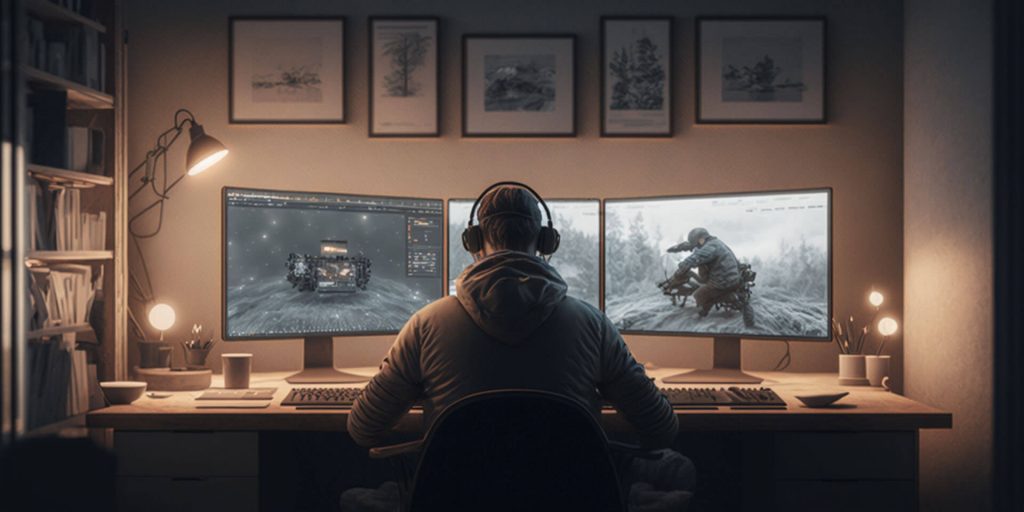Monitor response time is an essential aspect of any display, affecting both gaming and everyday use.
This comprehensive guide on How Monitor Response Time Affects Gaming and Everyday Use will explain what monitor response time is, how it affects gaming and everyday use, and how to choose a monitor with the right response time for your needs.
The time of response in gaming and everyday use has become increasingly important as technology advances.
With faster response times, you can experience smoother visuals and minimize motion blur.
In this comprehensive guide, we will discuss how it affects gaming and everyday use and provide useful tips on choosing the right monitor.
We will also answer some frequently asked questions and cover the impact of other monitor features.
How Monitor Response Time Affects Gaming | Detailed Guide
The pixel response time it takes for a pixel to change from one color to another, typically measured in milliseconds (ms).
Lower response times indicate faster pixel transitions, resulting in less motion blur and clearer images during fast-paced action.
Why Monitor Response Time Matters for Gaming
For gamers, a monitor’s response time is crucial, as it can significantly impact the gaming experience.
Here’s why:
Reduced Motion Blur
A fast response time helps reduce motion blur, making fast-moving objects appear sharper and more defined.
This is especially important in fast-paced games, like first-person shooters or racing games.
Input Lag Reduction
A lower response time can also help reduce input lag – the delay between input from a controller or keyboard and its corresponding action on the screen.
Reduced input lag leads to a more responsive gaming experience.
Competitive Advantage
In competitive gaming, having a monitor with a fast response time can provide a crucial advantage, as it allows players to react faster to in-game events and opponents’ actions.
Monitor Response Time in Everyday Use
While gaming is a primary focus for many when considering time for response, it can also affect everyday use:
Smooth Video Playback
A monitor with a fast response time can provide smoother video playback, reducing motion blur and ghosting effects during fast-moving scenes in movies or TV shows.
Enhanced Productivity
For productivity tasks, such as video editing or graphic design, a monitor with a quick response time can help reduce eye strain and improve the overall visual experience.

The Importance of Monitor Response Time
Gaming Performance
The pixel response time is a crucial factor in gaming, as it directly impacts the fluidity and clarity of on-screen actions.
In competitive gaming, a monitor with a lower response time allows players to react quickly and make better decisions in fast-paced games.
A monitor with a high response time may result in motion blur and ghosting, making it harder to track moving objects and impacting the overall gaming experience.
To learn more about gaming monitors and their features, check out our monitor buying guide.
Everyday Use
For everyday use, a monitor with a fast response time is still beneficial, as it provides smoother visuals when browsing the web, watching videos, or working on presentations.
However, the impact of response time is less noticeable compared to gaming scenarios.
If you’re looking for a monitor specifically for office work or productivity, read our article on the best monitor size for office work.
How to Choose the Right Monitor Response Time
When selecting a monitor, consider the following factors to find the right response time for your needs:
Comparing Response Times: 1ms vs. 5ms
A response time of 1ms is considered ideal for gaming, particularly for fast-paced games that require quick reactions.
Monitors with a 1ms response time, such as the ASUS VG248QE, provide crisp and clear images without ghosting or motion blur, ensuring an immersive gaming experience.
A 5ms response time is generally acceptable for everyday use and casual gaming.
While it may not provide the same level of performance as a 1ms response time, it is still suitable for most users.
To better understand the difference between the two, read our article on 1ms vs. 5ms response times.
Gaming vs. Non-Gaming Use
For gaming, look for a monitor with a response time of 1ms to 5ms, as this range provides optimal performance and reduced motion blur.
For non-gaming use, a response time of 5ms to 10ms is typically sufficient.
Everyday Use and Professional Needs
For everyday use, a response time of 5ms to 8ms is typically sufficient.
For professional tasks like graphic design, programming, or video editing, consider investing in a high-end eye care monitor that offers both fast response times and additional features to minimize eye strain.
Our guide on investing in high-end eye care monitors can help you make an informed decision.
TN, VA, or IPS Panel
Monitor panel types can also influence response time.
TN panels usually have the fastest response times but poorer color accuracy and viewing angles.
IPS panels offer better color reproduction and wider viewing angles but may have slightly slower response times.
VA panels provide a balance between TN and IPS, with decent color accuracy and response times.
Budget Considerations
Monitor prices can vary significantly based on response time and other features.
Be sure to compare the best monitors under $100 and the best monitor under $300 to find the right balance between response time and cost.

Additional Consideration
Refresh Rate
Refresh rate is another crucial factor in determining the smoothness of on-screen visuals.
A higher refresh rate, such as 144Hz or 240Hz, reduces screen tearing and provides a more fluid gaming experience. Learn more about the differences between 60Hz, 144Hz, and 240Hz refresh rates.
Resolution
Monitor resolution also plays a significant role in gaming and everyday use.
Higher resolutions, such as 2K or 4K, offer a more detailed and immersive visual experience.
To understand the differences between various resolutions, read our comparison of 2K vs 4K monitor resolution.
Panel Type
The type of panel used in a monitor affects response time, color accuracy, and viewing angles.
The three main panel types are TN (Twisted Nematic), IPS (In-Plane Switching), and VA (Vertical Alignment).
Each panel type has its strengths and weaknesses.
For a detailed comparison, read our guide on LCD vs LED vs IPS panels.
Adaptive Sync Technologies
G-Sync and FreeSync are adaptive sync technologies that help eliminate screen tearing and stuttering, providing smoother gaming experiences.
To enable G-Sync on a FreeSync monitor, follow our guide here.
Learn more about these technologies in our article on G-Sync technology.
Frequently Asked Questions
How can I minimize eye strain while using a monitor?
Invest in a monitor with features designed to reduce eye strain, such as low blue light, flicker-free technology, and adjustable ergonomics.
Read our article on monitor features for eye health for more information.
What is the ideal response time for a gaming monitor?
For gaming, a response time of 1ms to 5ms is ideal, as it minimizes ghosting and motion blur, providing a smoother gaming experience.
How does response time affect everyday use?
In everyday use scenarios, such as browsing the web, watching videos, or working on documents, a fast response time provides smoother visuals but is less critical compared to gaming.
Are curved monitors better for gaming and everyday use?
Curved monitors can offer a more immersive experience for gaming and increased comfort for everyday use, but the benefits depend on personal preferences and the specific monitor.
Read our guide on curved monitors for more information.
How do a monitor’s response time impact gaming and everyday use?
The response time of a monitor significantly affects both gaming and everyday use. It refers to how quickly pixels transition between shades. A slow response time leads to motion blur and ghosting, making it challenging to track fast-moving objects and reducing image quality during gaming and everyday tasks.
What role does a monitor’s refresh rate play in gaming and everyday use?
The refresh rate, measured in Hz, determines how many frames are displayed per second. A higher refresh rate enhances gaming and everyday use by providing smoother and more responsive displays. It reduces motion blur, improves fluidity, and enhances the overall viewing experience, making tasks like scrolling and navigating menus feel smoother.
Why is the response time an important specification for monitors in gaming and everyday use?
Response time is a critical specification for monitors in both gaming and everyday use. It measures how quickly a monitor can transition between images, ensuring a smooth and clear display. A low response time, measured in milliseconds, minimizes motion blur and ghosting effects. This is crucial for precise object tracking in gaming and contributes to better image quality and overall performance during everyday tasks.
Conclusion
Understanding how monitor response time affects gaming is essential for selecting the right monitor to meet your needs.
A fast response time is crucial for smooth gaming experiences, while it’s less critical for everyday use.
Consider other factors, such as refresh rate, resolution, and panel type, to ensure you choose the best monitor for your requirements.
Check out our comprehensive monitor buying guide for more information and recommendations.
